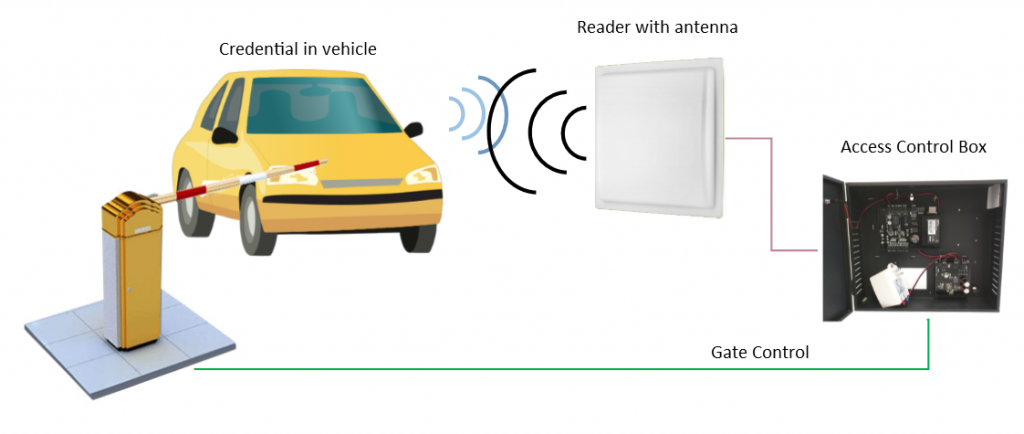What is the Best Long-Range Access Control System

Long-range access control systems extend the capability of door access control systems. They read a credential to open the lock. The standard access control systems have a card-to-reader range in inches, while the long-range readers have a range of over 25 ft. When you want to open a gate to a parking garage from your vehicle, it’s easier to use the long-range reader system.
This article compares long-range access control with a credential to one that uses mobile or smartphone credentials.
How Access Control Readers Read the Credential
There are two ways of communication from the credential to the door reader. The first uses a card credential and the second method uses a smartphone.
Door Access Using a Credential
All the readers communicate with the credential using a Radio Frequency ID (RFID) connection. The connection allows the ID number to be transferred from the card to the reader. The RFID short-range IP access control readers use 125KHz or 13.56MHz. These standard credentials are called proximity cards or smartcards (like MiFare). Long-range readers require battery-powered certificates to achieve extended range.

The proximity system has an inventive way of providing power to the credential (or card). It actually uses the energy sent from the reader’s antenna. The credential includes an antenna, a capacitor, and an integrated circuit that contains the ID number. When the card is placed within range of the reader, the antenna coil and capacitor, which form a tuned circuit, absorb and store energy from the field. This energy is rectified to direct current, which powers the integrated circuit. The chip sends its ID number or other data to the antenna coil, which transmits it by radio frequency signals back to the reader unit.
Long-range access control reader systems are very similar, except they use larger antennas for the reader. The larger antenna allows more energy to be directed at the credential. Some systems use passive credentials, while others use active credentials. The active credentials include batteries, so the credential must be replaced when the battery dies.
Long-Range Access Control System With Card Credential

Long-range access control reader systems use large antennas and credentials with a battery. The larger antenna allows more energy to be directed at the credential. Systems that use passive credentials (no battery required) have a maximum range of a couple of feet. The active credentials with batteries have a longer range, but the battery needs to be replaced.
The long-range reader is connected to the control box through a serial Wiegand-type connection. The control box connects to the local area network. If the credential is accepted, the control box sends a signal (relay connection) to open the gate.
The long-range reader uses higher frequencies, such as 865MHz, or 902MHz. Since this is a different frequency than the standard door readers, the credentials are different. These special credentials are available as a card or as a stick-on tag for the vehicle.
The standard and long-range readers use the same access control management software. This means that all the readers can be integrated into the organization’s system (except using different credentials). You can select IP door access readers with proximity credentials or biometric readers.
Door Access Using a Smartphone
A special door reader with smartphone connectivity is required when using a smartphone as the credential.
A mobile credential is an authorization token, much like a Prox card or keyfob. The ID number is held in your smartphone instead of a card. Like other types of credentials, it contains a unique number that can be used as the electronic key to open a door with an electric lock. The smartphone can connect to a door reader using Bluetooth, NFC, or WiFi. Bluetooth (BLE) is the most common type of communication used in the security market.
Bluetooth range is determined by the power available to the transmitter, the antenna, and the propagation conditions. For example, the signal can be attenuated if it passes through a wall. Standardization committees have established classes of power and range. The power and distance vary from Class 1, which uses about 100mW and has an operational distance of about 100m (328 ft.), to Class 4, which is approximately 0.5m (1.6 ft.)

Bluetooth is used to connect the smartphone to the door reader. The Isonas IP reader controllers and the Hartmann door access control system include a Mobile Credential option. The door readers have a maximum range of about 65 ft.
Summary of Long-Range Access Control Systems
Long-range access control systems are an extension of the standard door reader systems. They require higher-powered signals between the credential and unique readers to facilitate the long-range capability. There are two types of systems, one that uses a credential with a battery and the other that uses a smartphone. Credentials with batteries require occasional replacement, while smartphone credentials require the phone to be available.
For help selecting the right door access control system, please contact us at 800-431-1658 in the USA, or at 914-944-3425 everywhere else, or use our contact form.